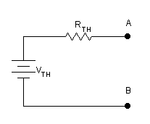The Electrician
Full Member level 5
- Joined
- Jul 13, 2010
- Messages
- 299
- Helped
- 141
- Reputation
- 282
- Reaction score
- 142
- Trophy points
- 1,323
- Location
- Pacific NW
- Activity points
- 4,593
This fact caught my attention initially, but I assumed it had been done so delibearately, in order to measure the current flowing from the left half to the right half of the circuit. I vaguely remember a similar concept as this in the modified nodal analysis (MNA).
MNA does allow computing the current through a wire, but that's for later in the OP's studies.
Hatmpatn, once you post a new schematic with labels as I suggested, we can proceed with developing the nodal equations.


